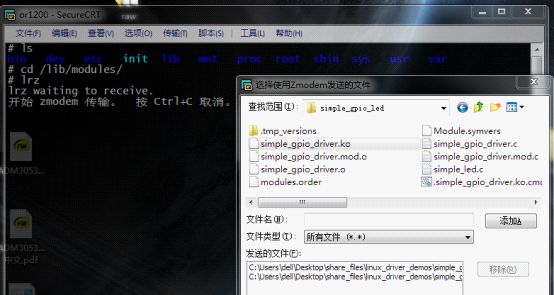OpenRisc-18-or1200下linux简单gpio字符设备驱动
好了,休息五天的第一次,公司没安排事情做就自己瞎搞咯,找后勤阿姨们吹吹水,调杯咖啡喝,上网看看新闻,基本上第一天上午我就是这样浪费的,现在下午的第一天,对了,最近研发新招来了三个研究生,两个是我们学校的师兄,但是对不起也要说一句了,真的好屌丝喔,怎么会沦落来和我这种级别的混了咧,好歹也是研究生们啊,哥······不吐槽了,有时候真蛮无语的,当然实际上现实生活没和他们谈过怎么会来这公司,不过现在和他们两个还蛮聊得来~
好~废话不多说了,前几次我们把linux给boot通了,这所谓的移植也只是个名头而且,真正的移植有时间可以去看看\arch\openrisc下的移植代码,强调我现在也是在用而已,按我的理解的话不是真正意义的开发。
那就继续先用这吧,好,现在回来《or1200软件环境搭建》的过程来,那时我们在虚拟机cross compile了lrz和lsz文件,这是因为什么,因为现在我们只是boot通了内核,除了UART这个外设之外我们在内核或模块程序中有关于ipcores的驱动,所以,我们想在这个最简单的内核上调试程序的时,至少在网卡调通之前我们能用串口下载程序代码,不幸中的万幸了,基于串口的通信协议来传输文件,而lrz和lsz就是串口的z-mode协议的实现。
好,既然如此,把lrz和lsz扔到openrisc-3.1\arch\openrisc\support\initramfs\bin目录下
回到ipcores上面,在opencores的网站上找到simple_gpio这个工程,下载下来。
添加到SOC上,按照我自己做的SOC,地址设置为0x91000000
千万千万记得,把板上的LED灯资源绑到GPIO Controller的端口上
Tcl脚本文件
现在打开openrisc目录下device-tree文件openrisc-3.1\arch\openrisc\boot\dts,
把最后关于simple_gpio的设备描述加上去
然后,按照《or1200移植linux》的过程重新编译linux源码,生成uImage即可。
重新download uImage启动之后,可在\bin目录下找到lrz和lsz
当输出lrz的时候会弹出传输文件框
现在可以随意找个文件测试一下板子的当前设置的baudrate下能不能无错传输。
对了,又想起一件事,上一届来公司的应届的学生,来了十几个,也就是我们这批了,有个兄弟前几天跟我说他辞职回桂林了,然后我就问题辞职你要干嘛,他就说回去跟一个小研发团队做项目创业去~估计3月底就撤了~至于什么项目这里就帮他保密一下了,但是我觉得做出来,推得早的话还蛮有市场的,这里也预祝下小朱能升级到朱总,哪天想起我就把我招过去当小弟就够了~呵呵~~~
好,基本步骤就此为止,现在转入到gpio字符驱动代码当中去。
参考宋宝华老师的《Linux设备驱动开发详解》第6章——字符设备驱动。
根据我自己的理解总结一下编写字符驱动模块的一般步骤:
1.根据自己编程习惯选择包含cdev的自定义结构体或直接使用cdev结构体。
2.例化file_operations结构体,然后填充文件操作的有关成员函数,并根据自己要求编写有关成员函数操作。
3.编写模块加载函数,包括io资源申请注册,中断号申请注册,设备号申请注册,内存申请,注册字符设备,
4.编写模块卸装函数,加载模块的逆操作。
5.封装成2.6内核的驱动设备模型platform机制,包括编写platform_driver模块加载函数和卸装函数,填充platform_driver结构体的probe,remove,suspend,resume等成员,编写各成员函数。
6.编写应用层的测试代码。
好,到资源栏下载我自己编写的simple gpio controller的字符驱动,对照一面的一般步骤一步步看代码
1.cdev结构体,这里我选择编写包含cdev的自定义结构体
- struct simple_gpio{
- void __iomem *base;
- struct cdev gpio_cdev;
- };
2.file_operations结构体
例化file_operations类,gpio controller operation
- struct file_operations gpio_ctl_ops = {
- .owner = THIS_MODULE,
- .read = gpio_read,
- .write = gpio_write,
- .unlocked_ioctl = gpio_ioctl,
- .open = gpio_open,
- .release = gpio_release,
- };
编写file_operation成员函数,只实现open和ioctl函数
- /******************************************* for file operations *******************************************/
- int gpio_open(struct inode *inode, struct file *file){
- struct simple_gpio *gpio;
- gpio = container_of(inode->i_cdev, struct simple_gpio, gpio_cdev);
- file->private_data = gpio;
- return 0;
- }
- int gpio_release(struct inode *inode, struct file *file){
- return 0;
- }
- ssize_t gpio_read(struct file *file, char __user *buf, size_t count, loff_t *f_ops){
- return count;
- }
- ssize_t gpio_write(struct file *file, const char __user *buf, size_t count, loff_t *f_ops){
- return count;
- }
- long gpio_ioctl(struct file *file, unsigned int cmd, unsigned long data){
- struct simple_gpio *gpio = file->private_data;
- switch(cmd){
- case LED_ON:
- simple_gpio_write8(gpio, SIMPLE_GPIO_DAT, 0x00);
- break;
- case LED_OFF:
- simple_gpio_write8(gpio, SIMPLE_GPIO_DAT, 0xff);
- break;
- default:
- printk(KERN_ALERT"led control : no cmd run [ --kernel-- ]\n");
- return (-EINVAL);
- }
- return 0;
- }
3.模块加载函数
这里说明下,函数大部分流程我放在platform driver的probe函数中实现
- /******************************************* for char device driver *******************************************/
- static int __devinit simple_gpio_setup(struct simple_gpio *gpio){
- cdev_init(&gpio->gpio_cdev, &gpio_ctl_ops);
- gpio->gpio_cdev.owner = THIS_MODULE;
- register_chrdev_region(MKDEV(GPIO_MAJOR, GPIO_MINOR), 1, "simple_gpio");
- return cdev_add(&gpio->gpio_cdev, MKDEV(GPIO_MAJOR, GPIO_MINOR), 1);
- }
- /******************************************* for platform device driver *******************************************/
- static int __devinit simple_gpio_probe(struct platform_device *pdev){
- int ret;
- struct simple_gpio *gpio;
- struct resource *io_res, *irq_res;
- /* get resources info*/
- io_res = platform_get_resource(pdev, IORESOURCE_MEM, 0);
- if (!io_res)
- return -ENODEV;
- irq_res = platform_get_resource(pdev, IORESOURCE_IRQ, 0);
- if (!irq_res)
- return -ENODEV;
- /* request memery for simple_gpio */
- gpio = devm_kzalloc(&pdev->dev, sizeof(*gpio), GFP_KERNEL);
- if (!gpio)
- return -ENOMEM;
- if (!devm_request_mem_region(&pdev->dev, io_res->start,
- resource_size(io_res), pdev->name)){
- dev_err(&pdev->dev, "Memory region busy\n");
- return -EBUSY;
- }
- /* map io memery to kenel space */
- gpio->base = devm_ioremap_nocache(&pdev->dev, io_res->start,
- resource_size(io_res));
- if (!gpio->base){
- dev_err(&pdev->dev, "Unable to map registers\n");
- return -EIO;
- }
- /* register simple_gpio char device */
- simple_gpio_setup(gpio);
- /* set outputs and light leds */
- simple_gpio_led_init(gpio);
- /* register interrupt */
- ret = devm_request_irq(&pdev->dev, irq_res->start, simple_gpio_isr, 0,
- pdev->name, gpio);
- if(ret){
- dev_err(&pdev->dev, "Cannot claim IRQ\n");
- return ret;
- }
- /* save struct gpio as device private data */
- platform_set_drvdata(pdev, gpio);
- /* mount into sysfs */
- gpio_class = class_create(THIS_MODULE, "gpio_class");
- device_create(gpio_class, NULL, MKDEV(GPIO_MAJOR, GPIO_MINOR), NULL, "led");
- return 0;
- }
4.模块卸装函数
与加载函数相同,流程放在platform driver的remove函数中实现
- /******************************************* for char device driver *******************************************/
- static void __devexit simple_gpio_clean(struct simple_gpio *gpio){
- unregister_chrdev_region(MKDEV(GPIO_MAJOR, GPIO_MINOR), 1);
- cdev_del(&gpio->gpio_cdev);
- }
- /******************************************* for platform device driver *******************************************/
- static int __devexit simple_gpio_remove(struct platform_device* pdev){
- struct simple_gpio *gpio = platform_get_drvdata(pdev);
- /* extinguish leds */
- simple_gpio_led_exit(gpio);
- /* remove data */
- platform_set_drvdata(pdev, NULL);
- /* unregister simple_gpio char device */
- simple_gpio_clean(gpio);
- device_destroy(gpio_class, MKDEV(GPIO_MAJOR, GPIO_MINOR));
- class_destroy(gpio_class);
- return 0;
- }
5.封装成platform机制
对于这个步骤,基本上是一个固定的格式,个人理解就是通用的字符设备驱动套进去platform机制,至于这个机制,很多blog都有解释,这里就不详细再说明了,主要是platform_device,platform_driver,bus三者之间的关系,platform_driver有一系列的操作函数,platform_device对设备的属性描述。
- #define simple_gpio_suspend NULL
- #define simple_gpio_resume NULL
- static struct of_device_id simple_gpio_match[] = {
- { .compatible = "opencores,simple_gpio", },
- {},
- };
- MODULE_DEVICE_TABLE(of, simple_gpio_match);
- /* work with hotplug and coldplug */
- MODULE_ALIAS("platform:simple_gpio");
- static struct platform_driver simple_gpio_driver = {
- .probe = simple_gpio_probe,
- .remove = __devexit_p(simple_gpio_remove),
- .suspend = simple_gpio_suspend,
- .resume = simple_gpio_resume,
- .driver = {
- .owner = THIS_MODULE,
- .name = "simple_gpio",
- .of_match_table = simple_gpio_match,
- },
- };
- static int __init simple_gpio_init(void){
- return platform_driver_register(&simple_gpio_driver);
- }
- static void __exit simple_gpio_exit(void){
- platform_driver_unregister(&simple_gpio_driver);
- }
6.测试文件
在linux应用层去做文件打开、读写、关闭操作相信学C的时候就应该有深刻的理解,这里的我们在驱动上没有实现read和write函数的具体操作,只实现了ioctl的操作,所以测试文件很简单,目的是看到LED灯闪烁的现象,所以只是简单打开设备文件,执行在驱动中定义好的命令而已。
- //------------------------------------- main ---------------------------------------------
- int main(void)
- {
- int fd;
- int ret;
- char *i;
- printf("\nstart simple_gpio_led_driver test ! \n\n");
- sleep(1);
- fd = open(DEVICE_NAME, O_RDWR);
- printf("fd = %d\n",fd);
- if (fd == -1){
- printf("open device %s error !\n",DEVICE_NAME);
- }
- else{
- while(1){
- ioctl(fd,LED_OFF);
- printf ("leds is off ! \n");
- sleep(1);//sleep for 1s
- ioctl(fd,LED_ON);
- printf ("leds is on ! \n");
- sleep(1);
- }
- // close
- ret = close(fd);
- printf ("ret=%d\n",ret);
- printf ("close gpio_led_driver test\n");
- }
- return 0;
- }
至于代码中有少量的注释,或者大家可以自己理解理解,当是自学的过程,主要还是参考宋宝华老师的书,有问题的话留言大家交流交流。
现在把simple_gpio目录挂到虚拟机里,然后在terminal中make,得到设备驱动模块文件
然后在terminal中编译simple_led.c文件
or32-linux-gcc -o simple_led simple_led.c
最后需要的是两个文件,simple_gpio_driver.ko,simple_led。
提取出来,然后在SecureCRT中输入lrz
将这两个文件添加到发送列表中,然后确定发送,
然后更改simple_led的文件属性
然后就可以加载module和运行测试代码
如果顺利的话,在加载模块的同时板子的上LEDs会同时light up。
对应加载模块后的内核信息
用modinfo命令可以看到在编写字符驱动时的模块信息
然后运行测试代码
在运行simple_led后,板子上LED 不断light up or down,同时在控制台上到有相应的提示信息输出。
到此,关于GPIO Controller的字符设备驱动就介绍到这里,如果目前想在驱动方面打发打发时间的话就可以啃相关的学习书籍······所以说目前我在公司就是这样打发时间的了~谁叫公司就养我在这又不给活我干咧~加油吧~
下一次写点什么也不知道了,好像还研究了frame buff和I2C一段时间,下次看看有没有能力总结经验出来,现在还是努力地先学,目前在看txj老师录的关于RAW-OS的培训视频,学,找回激情,保持激情,


















